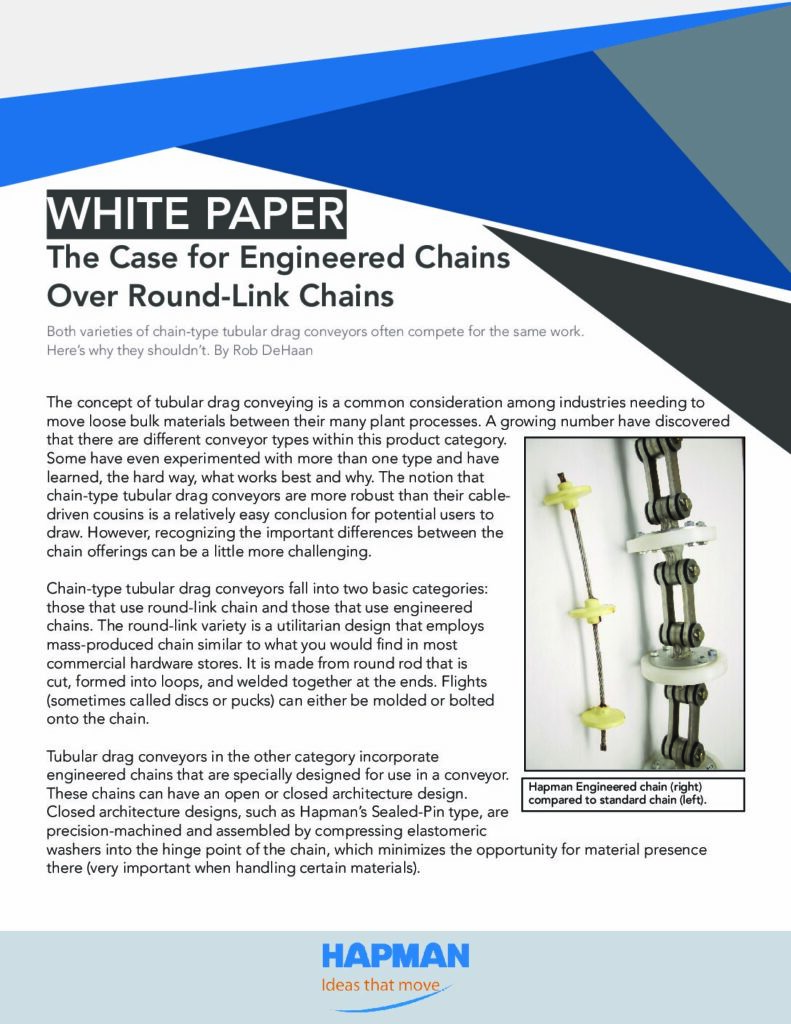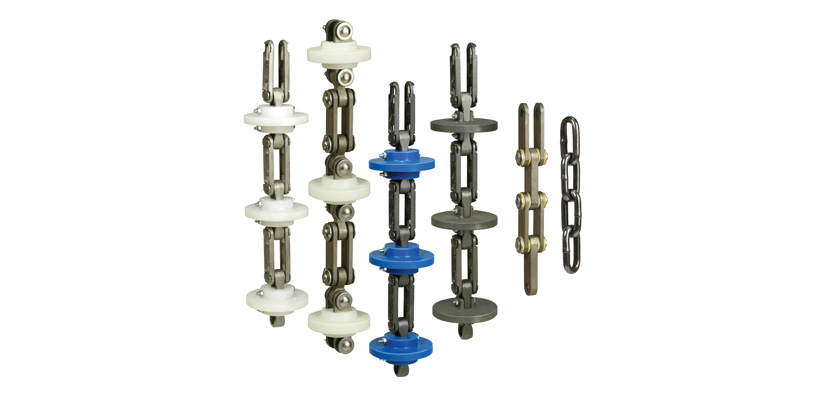
CHALLENGE
Round-Link Chains vs Engineered Chains, which chain works best and why?
INDUSTRY
Engineering
Both varieties of chain-type tubular drag conveyors often compete for the same work. Here’s why they shouldn’t.
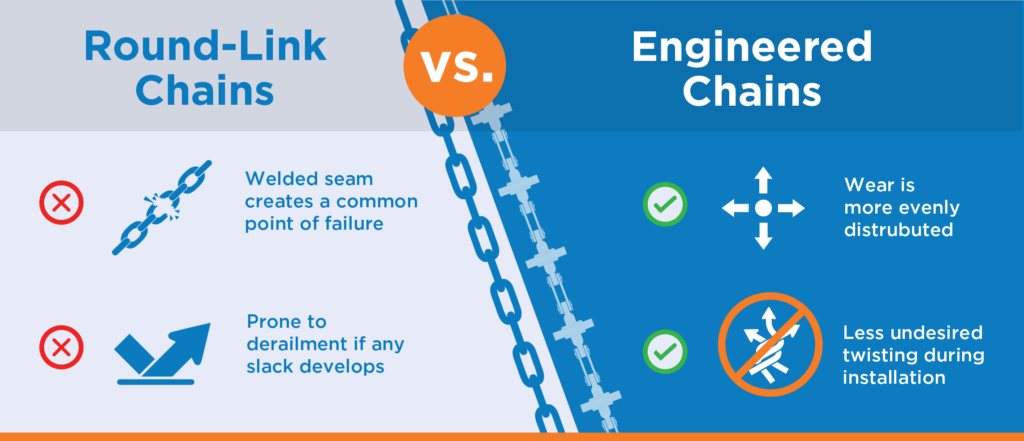
The concept of tubular drag conveying is a common consideration among industries needing to move loose bulk materials between their many plant processes. A growing number have discovered that there are different conveyor types within this product category. Some have even experimented with more than one type and have learned, the hard way, what works best and why. The notion that chain-type tubular drag conveyors are more robust than their cable-driven cousins is a relatively easy conclusion for potential users to draw. However, recognizing the important differences between the chain offerings can be a little more challenging.
Chain-type tubular drag conveyors fall into two basic categories: those that use round-link chain and those that use engineered chains. The round-link variety is a utilitarian design that employs mass-produced chain similar to what you would find in most commercial hardware stores. It is made from round rod that is cut, formed into loops, and welded together at the ends. Flights (sometimes called discs or pucks) can either be molded or bolted onto the chain.
Tubular drag conveyors in the other category incorporate engineered chains that are specially designed for use in a conveyor. These chains can have an open or closed architecture design. Closed architecture designs, such as The Case for Engineered Chains Over Round-Link Chains Hapman’s Sealed-Pin type, are precision-machined and assembled by compressing elastomeric washers into the hinge point of the chain, which minimizes the opportunity for material presence there (very important when handling certain materials).
There are some advantages to using round-link chains, including price. However, the performance and serviceability of engineered chains is significantly better, resulting in a much lower longer-term cost of owning, operating and maintaining a conveyor that uses them.
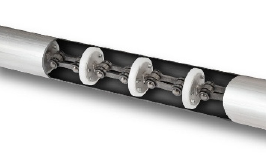
Here is a more detailed comparison of round-link and engineered chains:
- Round-link chain is more flexible, enabling more complex circuits with back-to-back bends that are out of phase with each other. But this kind of flexibility is rarely needed and comes with a significant downside: round-link chain is impossible to install without inadvertently introducing a lot of unwanted twist in the chain. Consequently, for the first several days after the conveyor is installed, the start-up procedure necessarily requires close monitoring of the inevitable accumulation of twisted chain. When that occurs, it is imperative that the conveyor be stopped immediately, before these wads of chain climb onto the drive sprocket and cause derailment or worse. At each occurrence, the master link must be located, the chain parted and the chain untwisted. This procedure must be repeated several times, and in the case of a long conveyor, can take a day or two to remove enough twist that it no longer accumulates.
- While too much twist is problematic, some twist is often desirable and necessary for certain conveyor routings to work. Engineered chains are therefore designed with that capability. Minimum distances vary from one chain to the next, and it is important to observe those distances when designing circuits so that the chain can articulate freely. This minor limitation is, by far, outweighed by the relative reluctance of these chains to twist. It is exceedingly easier to control and prevent undesired twisting during chain installation, which eliminates the aforementioned monitoring and dramatically shortens start-up time. This is particularly important in high production environments with short service windows, where users need the ability to replace chains very quickly.
- Of the many differentiating features of engineered chains, the one that most appeals to plant maintenance personnel is the fact that each link is individually serviceable. The chain can be parted and serviced wherever it is most convenient. There is no need to bump the conveyor or go searching for a master link, as is commonly required for round-link chains.
- Round-link chains notoriously spill material from one flight to the next because of flight tipping. Quite often, round-link chains will include wiper flights in an attempt to counter this phenomenon. Engineered chains naturally hold flights more firmly due to their longer pitch, so they are always perpendicular to the carry surface. This allows the conveyor to operate more efficiently.
- As mentioned previously, construction of round-link chains by nature includes a welded seam where the two ends of the round rod are pinched together. This seam is the most common point of failure.
Each of these two chain categories feature unique design philosophies and construction. As a result, there is some variation between them in terms of reliability and performance. - Conveyors with round-link chains most often include a spring-loaded chain tensioning mechanism. These devices are necessary to keep short-pitch chains engaged with the sprockets that drive them. They are prone to derailment if any slack develops.
Note: The ideal operating condition of any drag conveyor (not just tubular drags) is to operate without excess slack – NOT UNDER TENSION. However, tensioning the chain increases the inherent drag, which increases power consumption and, most importantly, wear. Using HP to overcome the extra inherent drag of a circuit naturally takes away from the amount of work that the conveyor is able to perform. - Engineered chains have a much longer and wider target. Therefore, drive sprocket teeth can be wider and longer for more positive engagement. By virtue of having more contact surface, wear is more evenly distributed. Greater engagement also makes the conveyor more slack-tolerant and allows the use of a simple jack-screw-type take-up mechanism. For the sake of operating in the ideal slack-free, un-tensioned condition, most users regard the occasional adjustment preferable to accelerated wear.
- Round-link chain drags are quite often supplied with an outer casing that is constructed of lightgauge tubing and joined together using compression couplings. By contrast, conveyors that use engineered chains generally have outer casings that consist of heavy schedule-40 pipe and are joined using weldon flanges that are cut from heavy plate stock. They are a structural component of the conveyor designed to endure the kinds of stresses that are common to industrial environments and can cause separation of “coupled” joints. Conveyors of the latter type can be tugged into a position to accommodate unanticipated misalignment issues during installation, without compromising joint integrity.
While both varieties of chain-type tubular drag conveyors often compete for the same work, clearly they shouldn’t. A thorough examination reveals a different design mentality and disparate calibers of equipment. Therefore, the only question is whether a given application is one that is important enough to demand the robust build and reliable performance of a conveyor that features an engineered chain.
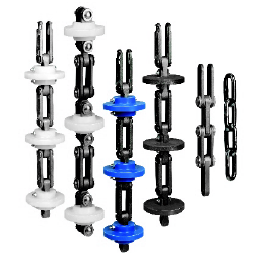
The 8 Advantages of an Engineered Chain
- Dramatically shorter start-up time
- Less undesired twisting during installation
- Fewer maintenance-related headaches
- More efficient operation with minimal spillage
- Eliminates the most common point of chain failure
- Less prone to derailment if any slack develops
- More positive engagement and even wear distribution
- Less joint separation under heavy stress
